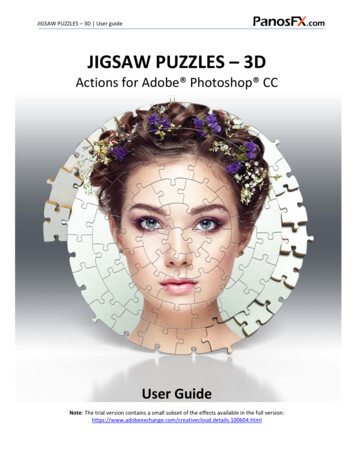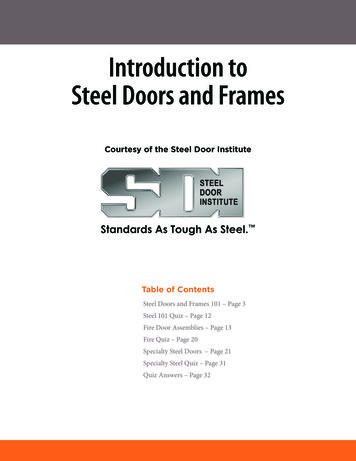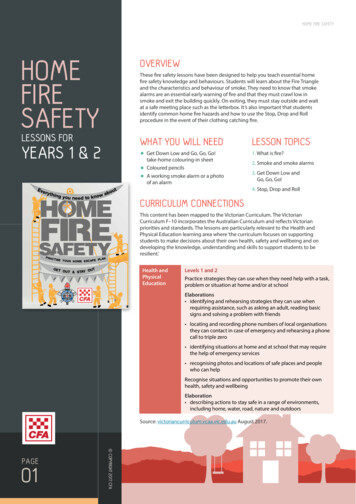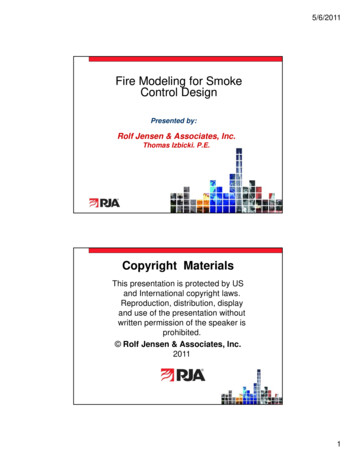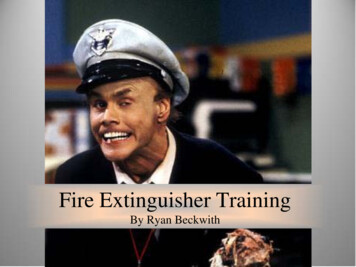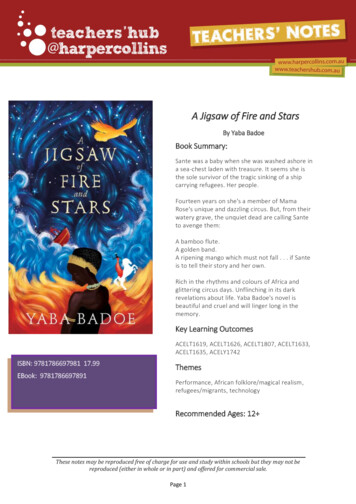
Transcription
A Jigsaw of Fire and StarsBy Yaba BadoeBook Summary:Sante was a baby when she was washed ashore ina sea-chest laden with treasure. It seems she isthe sole survivor of the tragic sinking of a shipcarrying refugees. Her people.Fourteen years on she's a member of MamaRose's unique and dazzling circus. But, from theirwatery grave, the unquiet dead are calling Santeto avenge them:A bamboo flute.A golden band.A ripening mango which must not fall . . . if Santeis to tell their story and her own.Rich in the rhythms and colours of Africa andglittering circus days. Unflinching in its darkrevelations about life. Yaba Badoe's novel isbeautiful and cruel and will linger long in thememory.Key Learning OutcomesACELT1619, ACELT1626, ACELT1807, ACELT1633,ACELT1635, ACELY1742ISBN: 9781786697981 17.99EBook: 9781786697891ThemesPerformance, African folklore/magical realism,refugees/migrants, technologyRecommended Ages: 12 These notes may be reproduced free of charge for use and study within schools but they may not bereproduced (either in whole or in part) and offered for commercial sale.Page 1
CharactersSanteCobra and CatCaptainLanguageThemesCircusFamilyAfrican folklore/magical realismRefugees/ MigrantsTechnologyAbout AuthorThese notes may be reproduced free of charge for use and study within schools but they may not bereproduced (either in whole or in part) and offered for commercial sale.Page 2
CharactersSante:“May your spear arm be strong, my daughter,” the tall man adds. “Your legs swift as agazelle’s, and your heart the mighty heart of a lioness protecting her cubs.” Page 2Sante’s parents leave her with this blessing.Discuss in which ways throughout the book Sante exhibits these traits.Think about:‘spear arm’ - in which ways does Sante fight and show courage?‘swift as a gazelle’ - when does Sante display her speed and movement?‘mighty heart of a lioness protecting her cubs.’. Who does Sante protect and why?Does she protect others more than she protects herself? Is this a good thing?What’s in a name?Sante discovers that she is named for Asantewaa, the Queen of the Ashanti peoplewho fought against British colonialism.Research and Discuss:Who are the Ashanti people?Who are Sante’s people in the book? And what freedoms does she fight for? Is peopletrafficking a form of modern-day slavery?The Ashanti people were said to be ‘gold-rich’ before British colonialism, and one oftheir symbols and sacred objects is the Golden Stool. As a baby, Sante is set adrift in achest full of treasure.Research and Discuss:What are the key objects in Sante’s treasure chest?How are they important to Sante, and in what way are they representative of herculture?What is the significance of the Golden Stool to the Ashanti people? And how does itlink to Sante’s parents?These notes may be reproduced free of charge for use and study within schools but they may not bereproduced (either in whole or in part) and offered for commercial sale.Page 3
Cobra and Cat:“’Found them in the forest,’ she says. ‘Would have turned out wilder than polecats if Ihadn’t fed and clothed them. Same goes for you, Sante,’ she tells me.” Page 8In much of children’s literature, an animal is anthropomorphised. Ie. it takes onhuman characteristics. Eg. The Little Red Hen. In A Jigsaw of Fire and Stars, YabaBadoe plays with this by reversing it - she uses zoomorphism - the humans take onanimal characteristics. This gives them an animal instinct - superior senses - to sniffout danger, to highlight their desires. Cobra and Cat are named for the animals theymost represent, and they act like them too.Cat is sometimes fierce like a wildcat: “Cat likes to hiss and spit and scratch,” page 12but also:“tender tabby Cat with kitten; unusually touchy-feely Cat nuzzles against her, pattingand caressing.” Page 62Write:If you were an animal, what would you be and why? Think about the characteristics ofyour animal; how does it move, use its senses, adapt to its environment?Think about how Badoe uses animal imagery to portray the characters throughout thetext.Exercise:What do the following phrases mean:“When she hugs me, I realise that I’m shaking like a terrified pup,” page 27“I’m more beast than fowl” page 70“we sprint fast as foxes,” page 67“huge bear of a man,” page 118“like two polecats in heat” page 80“Man’s madder than a ravenous hyena” page 120“Shiver and shake like a fox in a trap” page 132“black-boots were over us like ‘roaches in a sack of sugar” page 240Discuss:Why do you think it is the child characters who are portrayed as most animalistic?Think about the expression of emotion, basic needs, and the concept of being ‘wild’.These notes may be reproduced free of charge for use and study within schools but they may not bereproduced (either in whole or in part) and offered for commercial sale.Page 4
Sante isn’t named after an animal, but she does say: “Before I had memory, I hadPriss.” She can talk to Priss. Have you read any other books in which children have aclose bond with animals? In The Last Wild by Piers Torday, the protagonist Kester cantalk with the animals. In Northern Lights by Philip Pullman, the protagonist Lyra has adaemon - a morphing animal companion who is an extension of herself.Extension work:Compare and contrast Sante’s relationship to Priss to a similar relationship in anotherbook.“I talk to my bird, and as I do so, her pulse beats in time with mine, and we merge. Hergold-brown feathers swaddle my skin, her beak seals my mouth, and before I have timeto blink and take stock, I’m seeing the world as Priss does.”“I am Priss and Priss is me and we’re flying free!” page 169Think about what it means to be ‘eagle-eyed.’ Can you write or draw a description ofyour town as if you have an eagle-eye view of it.Think about the phrase ‘flying-free’. If you could fly free anywhere, where would yougo and why? Write a short passage describing your destination.But, by the end of the novel, Sante admits that she is “a creature that will never fly.”Page 294.Discuss:Do you agree with her? What else could flying mean, other than the physical sense ofit?The CaptainThe Captain has “eyes that could freeze a corpse” page 143, “a row of sunken teeth”page 144, “a voice as cold as the grave,” page 144 and “the power of his intent oozinglike poison from a boil” page 145. He also twirls his cane, but other than that Badoedoesn’t describe him with specifics. His real name isn’t revealed until much later inthe book.Discuss and Activity:Can you think why the author has described him so little and why she hasn’t given hima name. Can you try and draw a picture of what you think the Captain looks like.Does he remind you of any other villain?If you were inventing your own villain, what would he/she be like?LanguageThese notes may be reproduced free of charge for use and study within schools but they may not bereproduced (either in whole or in part) and offered for commercial sale.Page 5
The language in A Jigsaw of Fire and Stars is very distinctive.Activity:Look at the following passage and see how Badoe uses movement and rhythm in herlanguage. Highlight different aspects of the grammar and language that suggest thepeople she is describing are on the move:“I stamp out the embers of the fire and jump in the front of the truck with Cat. MamaRose is at the wheel, Cobra behind. Redwood and Bizzie Lizzie, Midget Man and Mimi –the rest of our crew – bring up the rear, while straight ahead Priss blazes a trail on a hotcurrent of wind. The way I am with her, I can almost feel the wind whistling through herfeathers. What she sees she tells me with tremors of her wing, an upward jerk of herbeak, a dip of her head. Beyond the fi r trees are rolling hills of olive groves, silverleaves whispering to the breeze. And in the far distance, fields of sunflowers clamour atthe sun. We’re in the foothills of southern Spain, on our way to the city of Cadiz to plyour trade.” Page 9Activity:Take Chapter 3 and imagine you are filming it. Spell out some directions for the filmcrew - what music would you use, what lighting, which camera angles? Write somedirection notes.How does the author use the senses in passages of description? Compare thefollowing passages:“In the late afternoon haze it looks like an ornate bowl of candied fruit rising from thesea. A dazzling bowl that whispers: ‘Come closer. Taste me. Take a bite out of me.’”Page 13“The sky, a pale simmering blue, crouches over us, licking up whispers of heat from thetarmac.” Page 66“We’re carried by trade winds across the Straits of Gibraltar to Africa. Priss soars andglides, swept by currents over mountain ranges, then purple valleys seeded with datepalms, grapes and guava We journey over savannah: grassland and stubble, hobbledacacia trees. Baobabs, giant scarecrows, dangle bulbous fruit on their arms. We veerwest and parched savannah turns into tropical forest: silk cotton trees, mahogany,ebony, teak. And in-between forest spaces, adobe thatched villages give way to zincroofed towns and sprawling cities with buildings that scrape the afternoon sky.” Page168-170These notes may be reproduced free of charge for use and study within schools but they may not bereproduced (either in whole or in part) and offered for commercial sale.Page 6
“I closed my eyes and breathed deep to gauge the scent of the building and hear theecho of past lives that once lived in it. The perfume of wood-smoke laced with a whiffof wild rosemary wafted out of warm ancient brick, built and extended by generationsof farmers. A farmhouse baked in the swell and glow of a rolling landscape of hills.Someone’s home, as well as a dwelling place for animals: for behind the reassuringsmells and sounds of the house – the footfall of someone walking down stairs, the barkand snuffle of a dog – was the snort of animals roaming in fields, the whinny of stabledhorses.” Page 203But one of the strongest tropes running throughout the book is the use of eyes. Fromthe phrase of the title, “A Jigsaw of Fire and Stars reflected in her eyes,” page 3, to thereferences to Cobra as ‘Green Eyes’, the villain called ‘Grey Eyes’, so much of theemotion of the book is conveyed through eyes; “we glean from the banter of our eyes– those glances and winks we use to communicate in the ring – what we’re going to donext” page 230Discuss:How important is sight in connection with the circus?“No need to throw daggers, when she’s already hurling ‘em with her eyes.” Page 75,and “my eyes embraced his,” Page 162Discuss:How important is eye contact in learning how someone is feeling?Exercise:1. Without talking, take a partner and ask them to hold a piece of paper over theirmouth. Without speaking they must use only their eyes to try to convey an emotion toyou. Can you read what it is?2. Collect a group of people into a circle. Place one person in the middle of the circle. Insilence, that person must make eye contact with one other in the circle. See ifeveryone can work out who they’ve made contact with.Themes:CostumesSante and her fellow performers dress up for their circus acts at the beginning andthe end of the novel. And the importance and preciousness of Sante’s tutu’s isrevealed halfway through the novel. But the costumes do more than just dazzle.These notes may be reproduced free of charge for use and study within schools but they may not bereproduced (either in whole or in part) and offered for commercial sale.Page 7
“’There’s no better hiding place,’ she says, ‘than what the eye can see and dismiss in ablink as vulgar circus glitter.” Page 84.“I put on the dress. Concha zips me up, turns me around. Red silk pinches so tight, mybum sticks out. I stare at the reflection before me. I twist and turn. My likeness twistsand turns as well. My reflection echoes me and yet isn’t wholly mine. Arms on hips, Ilook over my shoulder at the apparition staring back at me. Something doesn’t fit. And Idon’t mean the peel-me-off dress I’m wearing. I dress up every day when I’m working,and at times, playing with Cat, I pretend to be older. This is different, disconcerting, asthough I’m looking at a version of myself I’d rather not see; a presence that’s revealingitself at the same time as it draws me in.” page 135Think about the different outfits in the book, from“Mama Rose’s thinking flows freely when she dresses as a geisha.” Page 79to“Concha, complexion parchment white, in the black-and-pink costume of a matador;Concha, followed by endless images of boys and girls of all ages and races in a variety ofskimpy costumes and seductive poses. Their faces, every one of ’em, expressionless.”Page 210What is the power of costumes? Can they change how a person feels? Or hide anemotion underneath? “she puts on a circus smile,” page 145.Research:Explore what a geisha is. How has the role changed over time? Why do you thinkdressing as a geisha helps Mama Rose to think freely?Discuss and Activity:Think about the different outfits you wear. Pick one outfit. How does it make you feel?Does it disguise who you really are? Think about school uniform. Does your behaviourchange when you wear it?Design an outfit that would display your personality.Badoe describes the police as ‘black-boots’ throughout the novel.Pick one accessory that defines you.These notes may be reproduced free of charge for use and study within schools but they may not bereproduced (either in whole or in part) and offered for commercial sale.Page 8
CircusSante and her adopted family are travelling performers. One of Sante’s tricks is toperform acrobatics on the back of a horse.“’An evening of incredible tricks and daring feats created for your delectation alone.’She brings down her whip, a dash of sawdust mixed with gravel leaps into the air, andI’m on. Since before I could walk, she’s been training me. Bareback riding. Me and Taj inthe ring together. Me in a turquoise tutu studded with luminous stones. Taj’s mane ashower of silver ribbons. Drew the crowds when I was younger, still got the crowdwhere I want ’em today. A shining black girl on a white stallion, his flanks rippling andgleaming like seashells in moonlight. I’m bigger than I used to be, but Taj’s backremains broad and strong. I stand on his rump and, as he trots, flip forwards and landon his back, arms outstretched, a smile on my face. I execute a whole heap of flips inquick succession, then a handstand. I steady myself and slowly bend over backwards.Taj begins to canter, calm as you please, his rhythm steady, sure of every beat. Slowsdown as I straighten up, and then using his body as I would a wooden bar, slip underand over him. Legs straight, toes pointed, hips flexed, moving this way and that. After afinal somersault, I’m on the ground again, arms open wide, embracing applause.‘Bravo! Encore!’ I strut around the circle, back arched, Taj nodding and bowing withme. I wrap my hand around his ear and he snuffles my cheek. ‘Good boy, Taj,’ I say, andthe crowd yell for more.” Page 20Sante also plays music for Cobra’s circus act, and performs on the trapeze at the endof the novel.Discuss and Activity:Which circus act do you think Sante is best suited to and why?Can you design a programme for Mama Rose’s Circus?Imagine you are a circus performer. Which act would you perform? What would yourcostume be? Could anything go wrong?Look at other books about travellers, such as The Dreamsnatcher by Abi Elphinstone,and other books about the circus, such as Wild Boy by Rob Lloyd Jones. You mightlike to compare and contrast the above passage with Emma Carroll’s The Girl WhoWalked on Air, p 9.African folklore/magical realismThe publishers describe this book as being within the magical realism genre. It meansthat a book has a primarily realistic view of the world, and is set in the real world, buthas elements of magic.Research and Discuss:These notes may be reproduced free of charge for use and study within schools but they may not bereproduced (either in whole or in part) and offered for commercial sale.Page 9
Do you think it’s necessary to temper the horrific realities of people-trafficking with‘magic’ in a children’s book?How in the book is ‘magic’ expressed?Look at some Anansi tales, of the folklore character associated with slave resistance.What parallels can you find with Sante?The Ashanti people believe that the realm of the dead lies within the real world, but ishidden. Badoe expresses this in the text with the “shuffle of ancient footsteps inchingcloser” page 99, “the pitter-patter of the restless dead who insist on walking with us”page 115, and the “hazy silhouette” that “grazes the edge” page 154 of Sante’s visionand flits away.Research and Activity:Explore how the spirits turn from shadows into moths. Compare with the ‘soulbutterfly’ in Burmese mythology.Look at the illustration on page 236-237. How does it make you feel? What do youthink it is portraying?FamilySante is an orphan, and is adopted by Mama Rose:“The woman lifts me up: ‘Little one,’ she says. ‘My precious ’ Her dark, pebbled eyesloom over me. Sticky-out ears, stringy hair. She’s no beauty, but Priss can see she cares.I stop crying as she holds me tight to her chest, the way mothers are supposed to.”Page 6Discuss:How does Badoe show that Mama Rose is a ‘motherly’ figure in the novel?Sante describes how none of her ‘new’ family look like her. And the other twochildren were also ‘found’ by Mama Rose:“‘Found them in the forest,’ she says. ‘Would have turned out wilder than polecats if Ihadn’t fed and clothed them. Same goes for you, Sante,’ she tells me.” Page 8Discuss:Do you think this is true? How do you imagine things would have turned out for Santeif Mama Rose hadn’t found her? Would Sante still have been a circus performer? Howmuch do your parents influence what you do?“She [Priss] found me in the water. There was a mist next morning. One of thoseThese notes may be reproduced free of charge for use and study within schools but they may not bereproduced (either in whole or in part) and offered for commercial sale.Page 10
whirling sea-fog days that makes it hard to tell where shoreline begins and sea ends. Asort of blurring where time seems to stop. It was like that when Priss, flying beneath acloud, sees this big chest. She sees it, then hears a baby crying. Swoops to take a closerlook. Lands on me, almost tipping me over, so tries again. Second time round, shesteadies herself, and settles just below my feet. Talons scratch me and I squeal. Shecould tell I needed feeding, ’cause after I squeal, I start shrieking louder than abanshee. Priss doesn’t know what do. She’s a bird, a bright golden eagle. Eats rabbitsand rats, and, when she’s lucky, small flying creatures on the wing. There’s a wholeheap of things she can eat. Could have eaten a baby, I suppose. Fact remains she likedthe look of me: black face, big eyes. Just couldn’t figure out how to feed me. So shebrushes a golden wing over my face. The musty scent of her feathers, the soft swishand tickle of their kiss, quieten me. There are two of us now, Priss and me in the chest,as it drifts to the shore. The tide recedes, wedging us on a slipstream of seaweed. Prisswatches over me while, rattled by hunger, I cry myself to sleep.” Page 5Activity:Write a couple of paragraphs following this one, with a different start to Sante’s life,imagining that someone other than Mama Rose found her.With Cobra and Cat, Mama Rose, Redwood, Bizzie Lizzie, Midget Man and Mimi,Sante has a family: “a proper family. A real family.’” Page 13.Discuss and Activity:Is Sante’s family real because Mama Rose adopted her ‘on paper’? See page 12. Whatdoes this mean? What is a real family, a proper family?Draw a family tree of your family. Look at the different generations - which has themost members?Would you consider any of your friends to be your ‘family’? Where would you addthem in your family tree?What does Mama Rose mean by a ‘family circus’ on page 19?Think about the different personalities in Sante’s ‘family’. Do you have any ‘eccentric’personalities in your family?Sante misses her real parents and longs to know her origins. Once Mama Rose tellsher the story of the sea chest, Sante’s desire to know more about what happened toher family gets stronger. Sante explores her ability to commune with the spirits of herparents through dreams.These notes may be reproduced free of charge for use and study within schools but they may not bereproduced (either in whole or in part) and offered for commercial sale.Page 11
“The baby cleaves to me and her flesh becomes my flesh, and I see my mother as shedoes: large eyes smiling down at me, fingers tickling ribs, while the sun shines throughthe leaves of the magnificent tree. Leaves glimmer bright, a halo of dappled lightaround my mother’s head.” Page 171Discuss:What is the difference between dream and memory?Can Sante really remember what it’s like to be a baby?“And with the scent of mango on her breath, she kisses me.” Page 178.Activity:What’s your earliest memory? Can you write it down?Can you keep a dream diary for a week?Ancestry and ‘the Old Ones’ is an important concept in the book, both in terms ofSante’s inheritance and the wisdom of those around her, and a key element inAshanti culture.“Old Ones! Give ’em a chance and they spout riddles at you. Yet there’s truth in whathe’s saying.” Page 177The ‘older’ members of Sante’s family deviate between trusting and giving Sante andCobra freedom, but also thinking they are too young to cope on their own.Activity:What are the freedoms you’ve been given by your carers, and what are therestrictions? Could you make an argument for any of these to be changed?Refugees/MigrantsSante is a refugee, first discovered as a baby floating free from the sinking of aship carrying migrants to “Greener Pastures.” Page 85. “There we saw brown bodieslying dead on the shore,” page 86 and “Strangers pitch up on our shores and we herdthem into camps. They come in broken boats and we let them drown,” page 86Discuss:These notes may be reproduced free of charge for use and study within schools but they may not bereproduced (either in whole or in part) and offered for commercial sale.Page 12
What are the reasons people leave their homeland? Where does the term ‘greenerpastures’ come from/what does it refer to? Are they always greener?If you were leaving your home, and couldn’t pack all your things, what would be theone object that you would take with you?Imagine you are a migrant newly arrived in Europe. Can you write a letter home toyour parents telling them you are safe? What was the journey like? Were you scared?Sante is put on a treasure chest with a bamboo flute and floated free in the hope thatshe’s found. It seems she is one of only two survivors. In Rooftoppers by KatherineRundell, Sophie is the sole survivor of a shipwreck, floating free in a cello case.Discuss:What is the connection between music and the sea?What is the connection between music and migration?If you could inherit one song from your parents, what would it be? And if you couldonly pass on one song, what would it be?Look also at the role of music in A Story Like the Wind by Gill Lewis, another refugeestory set on a boat.Because she is a refugee or migrant, Sante often feels stigmatised and ‘other’.“If you’re not white, your life is cheap.” Page 108Discuss:What does Isaka mean by that?What evidence can you find in the text for Sante feeling ‘other’? Does she feel like anoutsider in more than one way?TechnologyThe Mama Rose circus live off grid:“We live off the grid as much as possible, ’cause the Old Ones and Priss like to breatheclean country air and do things their way. No interference from black-boots. Noelectricity, no gas bills. No tax to pay. No computers, television or phones. Hand-medown clothes when we need ’em from thrift shops. Makes us hardy. Survivors.‘Prepared for every eventuality,’ Redwood says.” Page 9-10These notes may be reproduced free of charge for use and study within schools but they may not bereproduced (either in whole or in part) and offered for commercial sale.Page 13
But later in the novel, Sante and her friends find that technology can be useful intracking criminal activity. She also finds phones powerful “whatever’s in thosemachines is mighty powerful, ’cause it’s drawing me in too.” Page 208Activity:Thinking about all Sante’s comments about technology, and the past lives of some ofthe ‘Olds’, can you write a list of pros and cons for living ‘off-grid’?Further Reading:The Other Side of Truth by Beverley NaidooWhat Sunny Saw in the Flames/Akata Witch (in the US) by Nnedi OkoraforThe Snow Angel by Lauren St JohnGorilla Dawn by Gill LewisBeyond the Bright Sea by Lauren VolkHell and High Water by Tanya LandmanAbout the AuthorYaba Badoe is a Ghanaian-British documentary filmmaker and journalist.A graduate of King's College Cambridge, she worked as a civil servant inGhana before becoming a General Trainee with the BBC. She has taughtin Spain and Jamaica and is, at present, a Visiting Scholar at the Instituteof African Studies at the University of Ghana, where she is completing adocumentary film -The Witches of Gambaga. Her short stories have beenpublished in Critical Quarterly and in African LoveStories: ananthology edited by Ama Ata AidooThese notes may be reproduced free of charge for use and study within schools but they may not bereproduced (either in whole or in part) and offered for commercial sale.Page 14
Rose's unique and dazzling circus. But, from their watery grave, the unquiet dead are calling Sante to avenge them: A bamboo flute. A golden band. A ripening mango which must not fall . . . if Sante is to tell their story and her own. glittering circus days. Unflinching in its dark revel


